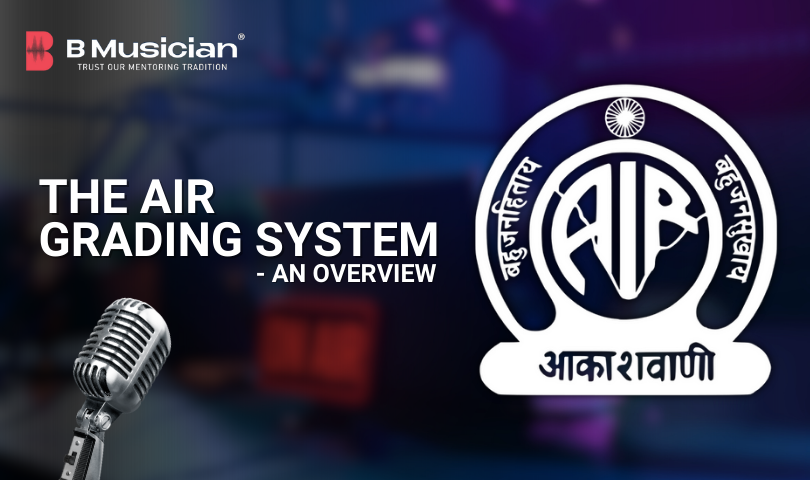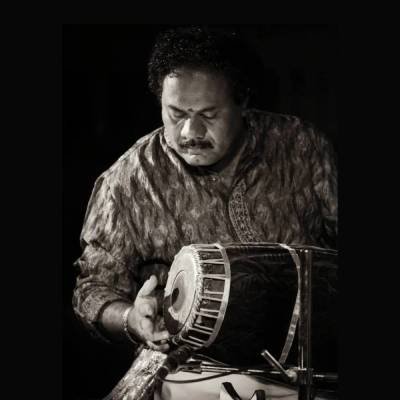What is AIR Grading system
The AIR Grading System (or) the All India Grading system is a prestigious evaluation framework designed to assess and recognise excellence in the field of music. Developed to honour outstanding talent and provide a structured pathway for musicians to achieve formal acknowledgment, the system has established itself as a benchmark in musical excellence.
When AIR started its grading system in the 1950s, it was one of the few national platforms that recognised and promoted Indian classical musicians based on structured assessments. It was conceived by a collective of renowned music scholars, veteran musicians, and academic institutions with the vision of nurturing artistic talent while maintaining high performance standards.
At its core, the AIR Grading System evaluates candidates through a rigorous process that includes theoretical examinations, practical performances, and a series of graded assessments. Each stage of evaluation is designed to measure a musician’s proficiency, technical ability, creativity, and overall musicianship. The grading board consists of eminent figures in the musical community, including senior artists, academicians, and experts in various instruments and vocal arts. Their combined expertise ensures that the grading process is both comprehensive and fair, reflecting the true abilities of the artists under evaluation.
The AIR Grading System was initiated as a formal recognition mechanism and has since grown into a respected institution in the music world. It emphasises continuous improvement and lifelong learning, encouraging musicians to refine their art at every stage of their career.
Different Grades, Preparation, and the Role of Music Schools Understanding the Grading Tiers
The AIR Grading System is structured into several grades, each representing a different level of mastery and proficiency. Generally, these grades range from the beginner level, where foundational techniques are assessed, to advanced levels that demand a high degree of technical skill, creativity, and performance maturity. The lower grades focus on core concepts, rudimentary techniques, and an introduction to the theoretical underpinnings of music. In contrast, the higher grades require candidates to demonstrate refined skills, intricate interpretations, and an understanding of advanced musical concepts.
Preparing for the Examination
Preparation for the AIR grading examination is multifaceted, combining dedicated practice with theoretical study. Aspiring musicians often start by acquiring a solid foundation in their chosen discipline through regular lessons, structured practice sessions, and participation in recitals. The examination process typically involves:
- Regular Practice: Mastery in music demands hours of disciplined practice. Students are encouraged to establish a routine that includes warm-up exercises, technical drills, and the regular practice of repertoire.
- Theoretical Study: Alongside practical skills, understanding music theory is crucial. This includes learning about scales, chords, harmony, and the historical context of different musical forms.
- Performance Preparation: Preparing for public recitals or mock examinations helps in building stage presence and managing performance anxiety. Many candidates participate in group classes or masterclasses to gain exposure to performance settings.
Eligibility & Process
Musicians aged 16 and above can apply. The selection involves submitting an application along with a performance recording (audio or video), followed by audition and grading by a panel of experts.
Syllabus Structure
B Grade (Basic Proficiency)
- Kritis: 2-3 major kritis in different ragas and talas
- Raga Alapana: Basic exposition in at least one raga
- Manodharma: Brief swara kalpana
B High Grade
- Advanced Kritis: Including varnam, rakti ragas
- Improvisation: Swaras, short neraval, alapana
- Stage Maturity: Consistency and tonal quality
A Grade
- Repertoire Depth: Rare kritis, complex talas
- Manodharma Mastery: Full alapana, neraval, kalpana swaras
- Stage Experience: Professional-level artistry
Top Grade
- Exemplary Artistry: Innovation within tradition, deep raga bhava
- Recognition: National level contribution and peer acclaim
Note:
Grading is dynamic and based on overall musicianship, not just syllabus completion.
Prerequisites and the Role of Music Schools
Before embarking on the AIR grading process, candidates are expected to meet certain prerequisites. These prerequisites vary depending on the grade level and the specific instrument or vocal category. For beginners, a fundamental understanding of basic music theory and some preliminary training on the instrument are often sufficient. For higher grades, formal education in music—often obtained through music schools or conservatories—is highly beneficial.
Music schools play a pivotal role in preparing candidates for the AIR grading examinations. They offer:
- Structured Curriculum: Comprehensive courses that blend practical and theoretical training.
- Experienced Instructors: Teachers who have often themselves been assessed by the AIR system and can offer insights and personalised guidance
- Performance Opportunities: Regular recitals, competitions, and ensemble practices that provide real-world performance experience.
Various schools of music have aligned their teaching methods with the AIR grading standards, ensuring that students not only learn to perform but also to appreciate the depth and historical significance of the art form. Whether it is classical Western music, Carnatic, Hindustani, or other regional forms of music, many institutions customise their curricula to meet the rigorous demands of the AIR grading system.
Celebrated Musicians and Artists Graded by AIR
The impact of the AIR Grading System is best exemplified by the numerous accomplished musicians who have been recognised under its framework. These artists, spanning various categories such as vocal, instrumental, and ensemble performance, have made significant contributions to the world of music.
The first set of musicians to be graded by AIR were some of the stalwarts who are now regarded as legends. Here are a few examples across different categories of mastery:
Vocal (Carnatic and Hindustani)
Hindustani Vocal
- Pandit Omkarnath Thakur – One of the earliest graded artists; renowned for his powerful voice and musical scholarship.
- Ustad Bade Ghulam Ali Khan – Thumri and khayal maestro; was given top AIR grading (Top Grade/A-Top).
- Pandit Bhimsen Joshi – One of the earliest graded artists; later became a National icon and Bharat Ratna awardee.
Carnatic Vocal
- Semmangudi Srinivasa Iyer – One of the first Carnatic vocalists to be recognised by AIR since 1958.
- D.K. Pattammal – Among the first women graded for Carnatic vocal on AIR. She was acclaimed for giving her first performance at Madras Corporation Radio (now known as AIR) at age of 10, in 1929.
- M.S. Subbulakshmi – Iconic voice, widely promoted through AIR even before her global fame. She was the first musician to be awarded the Bharat Ratna award, India’s highest civilian honour, in 1998.
Instrumental (Melody Instruments)
Hindustani Instrumental
- Ustad Vilayat Khan (Sitar) – Graded early and performed frequently on AIR.
- Pandit Ravi Shankar (Sitar) – Also featured in early AIR broadcasts, eventually a global icon.
- Ustad Bismillah Khan (Shehnai) – Among the few shehnai players to achieve “Top” grade status.
- Ustad Ali Akbar Khan (Sarod) – Was one of the earliest to be rated among the best by AIR.
Carnatic Instrumental
- Lalgudi G. Jayaraman (Violin) – Early graded artist; revered for his accompaniment and solo work.
- T.R. Mahalingam (Flute Mali) – First flautist to receive top recognition via AIR.
- Emani Sankara Sastry (Veena) – A top-graded veena artist and AIR composer.
Percussion
Hindustani Percussion
- Pandit Kishan Maharaj (Tabla) – One of the earliest tabla vidwans graded by AIR.
- Ustad Alla Rakha – Popularized tabla and frequently aired on AIR since the 1950s.
Carnatic Percussion
- Palghat Mani Iyer (Mridangam) – The first mridangam vidwan to receive A-Top grade from AIR.
- T.K. Murthy – Long-time AIR artist, known for his precision and accompaniment.
- Dr Prapancham Ravindran– is one of top most percussionist, Mridangam maestro, virtuoso who is frontrunner of Thanjavur style of playing, and a master of innovative teaching techniques. He is a “A TOP” graded artist from AIR, Chennai.
Notes on the AIR Grading System
- Grades: B, B-High, A, and A-Top (now includes Top grade).
- Selection: Based on auditions, past performances, musicianship, and contributions.
- Impact: AIR grading became a defining credential for classical musicians in India for decades.
Overall Summary and Conclusion
The AIR Grading System stands as a testament to the importance of structure, discipline, and excellence in the field of music. By providing a clear framework for evaluating and recognising musical talent, the system has not only elevated the standards of musical performance but has also played a pivotal role in the education and development of countless artists. From its inception, the AIR Grading System has been built on the principles of rigorous assessment and continuous improvement, ensuring that only the best and most dedicated musicians earn their place among the certified.
Recap of Key Points
- Definition and History: The AIR Grading System was developed to evaluate and honour musical talent through a comprehensive process involving both theoretical and practical assessments. Established by a consortium of music experts, it has evolved to become a respected institution in the music community.
- Grading Tiers and Preparation: The system is divided into multiple grades, each representing a distinct level of proficiency. Preparation for these examinations involves a balanced mix of technical practice, theoretical study, and performance training. Music schools play a crucial role in aligning their curriculum with the AIR standards.
- Profiles of Accomplished Artists: The system has certified a wide array of talented musicians across various categories such as vocal, violin, mridangam, veena, flute, and gatam. These artists serve as both role models and proof of the system’s efficacy in nurturing musical excellence.
- Impact on the Music Industry: Beyond individual achievements, the AIR Grading System has contributed to raising the overall standard of music performance. Its influence can be seen in the disciplined approach adopted by music institutions and the high-quality performances of its certified artists.
Final Thoughts
In conclusion, the AIR Grading System is much more than just a certification process—it is a dynamic, evolving framework that supports the growth of musical talent through rigorous evaluation and continuous learning. Its comprehensive approach ensures that musicians are not only technically proficient but also deeply connected to the artistic and cultural dimensions of their craft. As the system continues to evolve, it promises to keep pushing the boundaries of musical excellence and inspiring future generations of artists.
For musicians, educators, and enthusiasts alike, the AIR Grading System represents a commitment to quality, dedication, and the timeless pursuit of artistic excellence. Whether you are a budding musician preparing for your first examination or a seasoned artist striving to refine your skills, the AIR Grading System offers a structured path to achieving and maintaining excellence in the vibrant world of music.


















